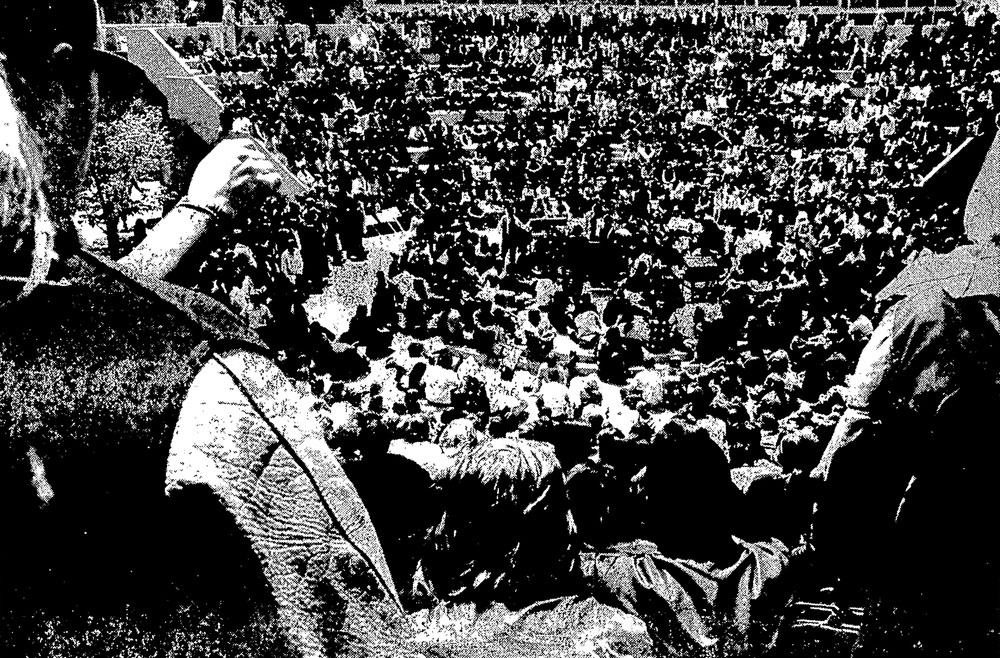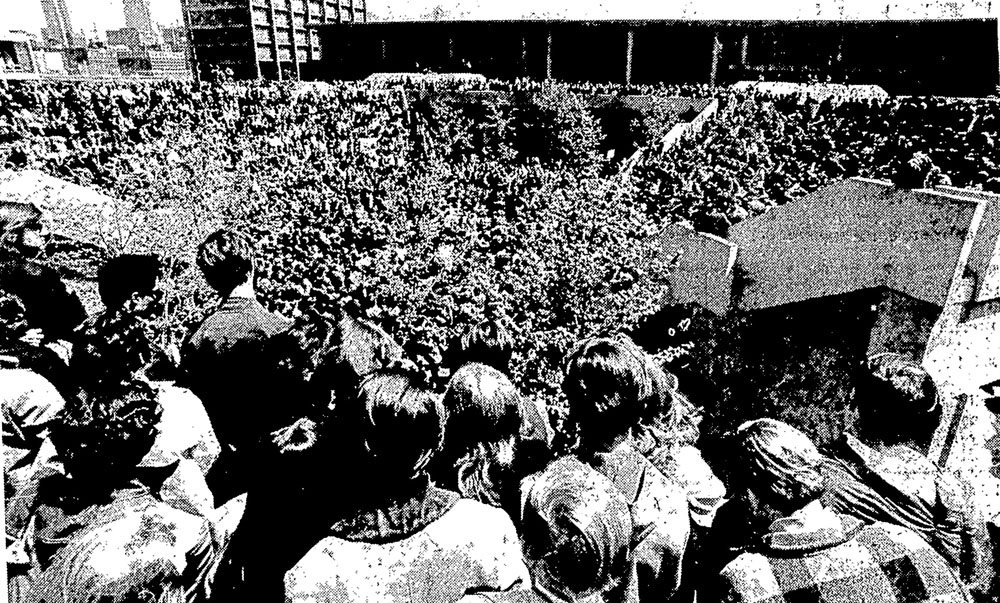 Download PDF of this full issue: v50n2.pdf (24.8 MB)
Download PDF of this full issue: v50n2.pdf (24.8 MB)From Vietnam Veterans Against the War, http://www.vvaw.org/veteran/article/?id=3886
 Download PDF of this full issue: v50n2.pdf (24.8 MB) Download PDF of this full issue: v50n2.pdf (24.8 MB) |
In the two years after my discharge from the Navy and my return to the Chicago area with my wife and daughter, Martin Luther King, Jr. was murdered; Robert F. Kennedy was murdered; Fred Hampton and Mark Clark were murdered. And, the immoral war against the Indochinese people expanded. Now it was 1970's turn.
May 4, 1970, 9:00am. I completed my overnight shift at the Chicago Daily News and drove over to Circle Campus for a full day of classes. I had one more quarter to go to finish my bachelor's degree in political science at the end of 1970. Though I had a full-time job and a family to support, I was taking a full load of classes each quarter. The GI Bill was not going to waste.

|
Sometime after 11:00am that day the news hit campus about the National Guard shootings at Kent State. People coming out of classes were huddling together, discussing what apparently happened. There was an immediate need to express anger and dismay. For many, classes were now the least of our concerns. In effect, we students "cancelled" all classes for the rest of that day.
Small groups of students carried makeshift protest signs around the campus. Wild rumors flew around campus that nine, then 10, students had been shot and killed at Kent. I joined one small group of about ten or fifteen fellow students who marched with signs along the edge of campus on Halstead Street to be more visible to the public.
After a couple of hours, I decided to head home, since I needed to get some sleep before my night shift. I shared the day's events with my wife, had some dinner, and got to sleep. I wondered what the situation would be at work that night.
When I got to work at 11:00pm, the city room was somewhat crazed. This overnight shift was the busiest time for the Daily News, as it was an early afternoon paper. All the editorial work was done overnight. The focus this night was the events at Kent and the aftermath beginning to hit campuses throughout the city.
By Tuesday morning, May 5th, newspapers were filled with stories of protests across the country. In Chicago, most, if not all, colleges and universities were dealing with the question of a national student strike. [Eventually, this would also include many high schools!]
I got to campus around 9:00am, wondering if there were going to be any classes at all. There was a planned noon meeting at the Greek Forum, a central gathering place that was often used for anti-war activities. I joined approximately one thousand other students at that meeting to discuss and debate the need for a student strike.
Coming out of that meeting, according to campus reports at the time, around 800 students (me included) marched from the Forum to the ROTC offices located inside the Roosevelt Road Building (RRB). Nearly one hundred students actually managed to get inside. There was some destruction, broken windows and such. Some plainclothes cops and university police were injured while removing the students who occupied the offices.
Most of us stayed outside to see what the cops might do. Though not part of the activist student organizations at this time, SDS, PL, YSA, I was certainly a partisan to the general mood of anger over the Kent killings and the role that ROTC played in sucking young people into war.
After I left campus that afternoon, a group of students marched to University Hall, where the administration offices were located. They occupied the whole eighteenth floor.
At some point a fire broke out on the sixth floor, causing $20,000 damage, according to the fire department.
In more ways than one, things were heating up on Circle Campus, as was the case on more and more campuses across the country.
One thing I should point out, for those who may not know. In 1970, Circle Campus had no dorms where organizing activities might be planned. This was a "commuter university," with students taking buses or subways from wide areas of the city, or driving in from the suburbs. One could say that the majority of students were NOT from privileged backgrounds, this was actually a working-class campus in many ways. It is useful to keep this in mind as we see the high level of organizing and action that took place over the ensuing days and weeks.
By Wednesday, May 6th, the Chicago Daily News, as well as other papers in the city, headlined some of the Tuesday events: "3 colleges shut down here"; "NU closed for rest of week; student strikes spread".
Once again, after work, I headed back to campus.
Some four thousand students and faculty participated in another huge rally to decide whether or not to extend the strike. The answer from all of us was a resounding "Yes!". What a sight that was! This was real education, involved education, actual participatory democracy.
Following the rally, we marched through campus to urge the faculty to dismiss classes and join in the strike activity. Some eighty students returned to the ROTC offices to sit-in. The University issued a warning that all persons remaining past 9:30pm would be arrested for criminal trespass.
Though the students were "assured" that Chicago cops would not intervene, a task force was stationed outside the building. Thirty-five students who decided to remain were arrested. More than one hundred students were gathered outside the building to protest the arrests. When they refused to disperse, the cops used force to clear the area.
Forty-one students were arrested…...The "Circle 41".
Thursday, May 7th, there was another large gathering of nearly 3,000 students. I came to campus after work to join in whatever was going on, though I was wary about getting caught up in anything involving the Chicago cops. This meeting called for the dropping of charges against the "Circle 41" and for an immediate and total shutdown of the university.
Then, another march, this time to the Chicago Circle Center (student union). Some groups broke off to enter lecture halls in an effort to disrupt classes and barricade some classrooms.
Later that day, Chancellor Norman Parker finally announced the closing of the university until Wednesday, May 13th. In addition, the Art and Architecture Building (AAB) was opened to students for use as "Strike Central" for the whole city!
Very little was being written about activities at Circle Campus in the "movement press". Most focused on the larger, more well-known campuses like Northwestern, the University of Chicago, or the campus in Champaign-Urbana. Our "commuter university" seemed to be rather insignificant.**
However, for me, this week of activities and the sense of being a part of something larger, something nationwide, pushed me a little further along the path of activism.
By August of 1970, I connected with Bart Savage, then a leader and central organizer of the Chicago Chapter of Vietnam Veterans Against the War. I finally realized that I must belong to an activist organization that connected my veteran status with my political beliefs. It was time to join something meaningful. I could no longer deny that I was a Vietnam Veteran against the war, against the political repression of social justice advocates, and for a radical reconstruction of the way the world worked.
Since that time, though I could not always participate actively in VVAW events, no matter where I was, home or abroad, I never looked back. I would always be a Vietnam Veteran Against the War.
**: One exception was a piece by Randy Furst for the May 19, 1970, issue of The Militant (weekly newspaper of the US Socialist Workers Party), "Students Press for Control at University of Illinois".
Joe Miller is a Navy veteran, 1961-68. Naval Security Group, 1961-64. USS Ticonderoga (CVA14), 1964-66. HELTRARON 8, 1966-68. He is a VVAW National Board Member.

|